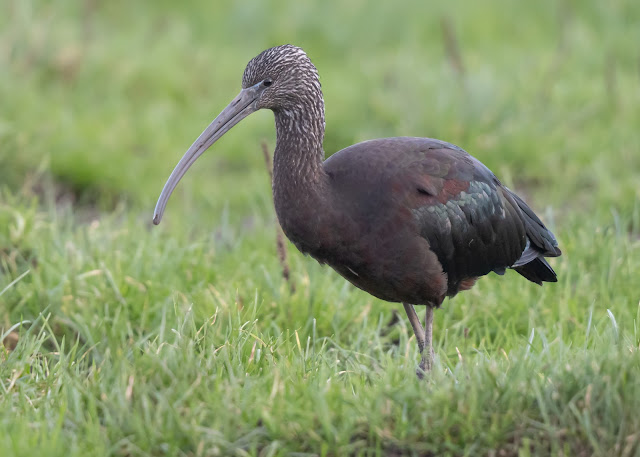I mentioned in my last blog that I was planning a visit to Slimbridge to try and photograph a very showy Glossy Ibis, a bird that I see most years in the UK but have failed to photograph to my satisfaction. I remember one occasion when one was in paddocks where it spent all its time behind fencing. It would walk slowly to the end of the fencing feeding all the time but when it got to the end of the fencing rather than walk out into the open it would turn around and go back down the fencing line! This pretty much sums up my experience of, what have always been to me at least, these shy birds. So on Friday morning, with half reasonable weather forecast and a free day after walking the dogs, I set off to Slimbridge.
Set in the background of general decline , the heron family have been one of the very few UK avian positives in recent years. I talked about the UK colonisation of Egrets in a previous blog. In the short space of time since that blog numbers have continued to increase with a truly remarkable 300 plus Cattle Egrets currently in a flock in Somerset. It was as recent as 2008 that Cattle Egrets first bred in the UK and the Colins bird bible published in 2009 listed them as a one star rarity.
The Glossy Ibis UK sems to be next on the list for UK colonisation with a remarkable 70 birds reported in the UK last week including a flock of 15 birds on the Isle of Wight. It surely is only a matter of time before the first successful breeding attempt.
Humans have a long history of special relationships with the exotic ibis family. The ancient Egyptians, who thought animals were incarnations of gods on Earth, worshipped the sacred Ibis as the god Thoth, who was responsible for maintaining the universe, judging the dead, and overseeing systems of magic, writing, and science.
The Glossy Ibis had been roosting on the main Slimbridge site with some Cattle Egrets and then flying out onto the approach road by the canal to feed in a grassy field. I parked up just beyond the canal bridge and looked for the Ibis but could not see it. I enquired of it from another photographer who told me it was under the hedge we were standing in front of! I walked down to a gate which gave a view along the base of the hedge and sure enough there was the Ibis. It could have been not more than 2 meters away from us when I talked to the other photographer. Over the next hour or so, as many other admirers came and went, it never moved more than 50 meters out into the field, all the time probing the muddy ground with its remarkable long curved bill.
With many photographs now safely captured on my memory card, I moved onto the main WWT site and went around the hides close to the visitors centre. At this time of year this whole area is crowded with wintering wildfowl, Bewick Swans and waders. I watched a large mixed flock of Black-tailed Godwits and Curlew probing the soft earth in Ibis fashion, clearly this was a very fertile feeding ground. A solitary Spoonbill was at the back of the Rushy slowly sweeping the water with its bill for food. The Spoonbill is another exotic member of the Heron family becoming established in the UK. From the estuary tower I saw some of the large flock of White-fronted geese that are currently onsite.
My tummy was now rumbling and so I made my way to the Kingfisher restaurant for a snack lunch where I bumped into Ewan and Mark. We gossiped for a while and then said our goodbyes but as I was packing up I noticed that Ewan had left his scope behind. After a quick phone call Ewan was soon back to collect his forgotten kit. I spent the next hour or so going around the hides on the other side of the reserve but these were much quieter than the ones on the Rushy side. There was a large flock of Dunlin and Golden Plover, all new for the year list, feeding distantly on the grass from the Zeiss hide.
I left Slimbridge with my embryonic year list much improved and made my way to a site a few miles away where a Tawny Owl is known to roost. My birding mate Nick had given me very clear location instructions but, although I thought I was staring at the right tree, I could not see the Owl. This was not helped by the fact that it was pouring down with rain drenching the lens on my bins. I messaged Nick again who told me that Ewan and Mark had seen the Owl an hour previously and he gave me very exact instructions as to where the roost was in the tree. The Owl was now immediately obvious, I could not believe I had not seen it before!
 |
| Sleepy Tawny Owl |
I departed for the short journey home wet but with a happy feeling of mission accomplished!
Footnote – my blogs are posted with sometimes rather imaginative spelling and grammar due to my extreme dyslexia!





Pics still better than mine even in the rain :-)
ReplyDeleteLovely photos. So nice to be able to see bird in close up. Thank you!
ReplyDelete